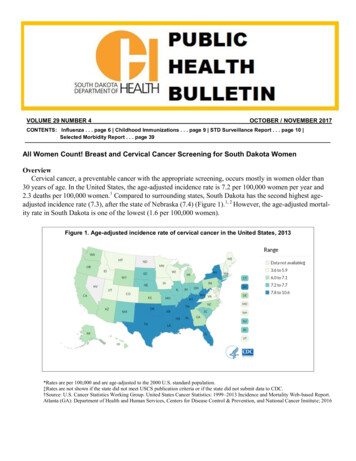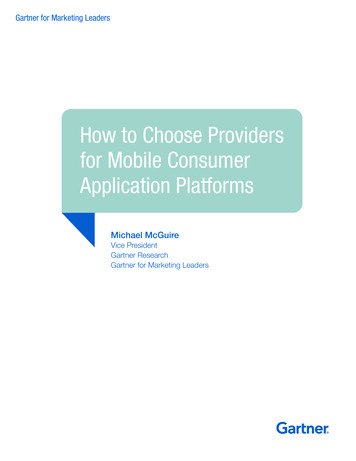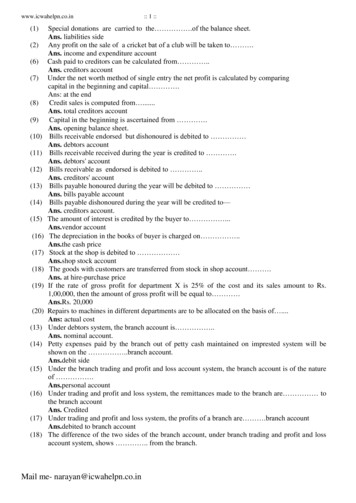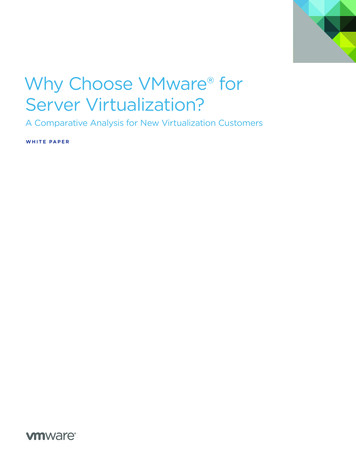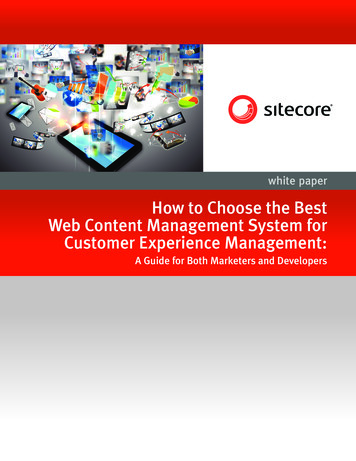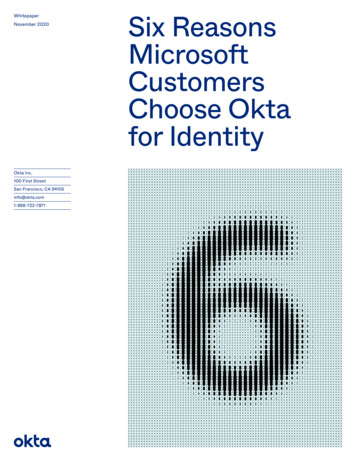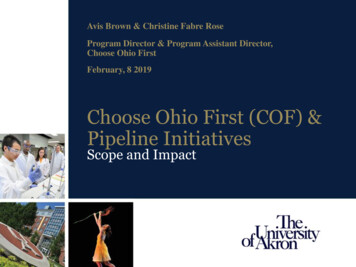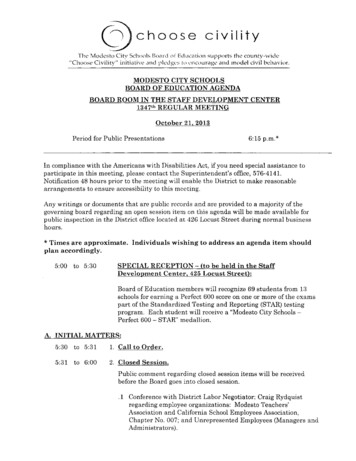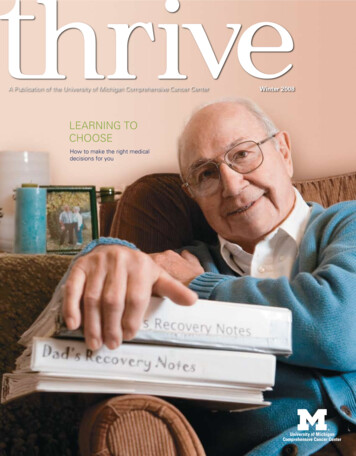
Transcription
A Publication of the University of Michigan Comprehensive Cancer CenterLearning toChooseHow to make the right medicaldecisions for youWinter 2008
In this issue winter 2008on the cover:Louis Spino, a pancreaticcancer survivor, carefullyconsidered his treatmentoptions before choosinga plan offered by the U-MCancer Center.Photo by Martin Vloet, U-M PhotoServices04 targeting thesource06 Peace of MindCancer Center Director Maxcoping with the financial impactHow do you decide on a cancerWicha, M.D., discusses theof cancer.treatment? Find out how LouisThrive offers 10 strategies for10 Learning toChoosepromise of cancer stem cellSpino found the best optionresearch.for him.WRITEWe want to know what youthink. What kinds of storieswould you like to read inThrive? What type of advicewould be helpful? Do youhave tips for other patients?13 TELLING STORIES14 A Temporary FixLet us know. E-mail us atLarry Hoffman, who has multi-What to expect when temporaryThriveMagazine@med.umich.ple myeloma, relives his days intube feeding is necessary—andU-M experts discuss the latestedu or write to us at 2901the U.S. Air Force as part of hiswhy, for some, it comes as anews in cancer research andHubbard, Suite 2600, Annwork with the Cancer Center’ssurprising relief.what it means for you.Arbor, Mich., 48109.new Creative Writing Program.The ViewfromAboveOn the four floors directly above the U-M CancerMeanwhile, our clinics are already advancing cancerCenter’s clinics, an army of researchers is working towardtreatment with the help of patients who volunteer tothe same goal you are: To find a cure for your cancer.participate in studies. In our cover story, we talk to aWe’ve given you a sneak peek inside a lab in thispatient who decided to enroll in a clinical trial with ourissue where research is underway that could changeMultidisciplinary Pancreatic Cancer Clinic—one of theeverything about cancer care. Max Wicha, M.D., thenation’s leading centers for this type of cancer, in largeCancer Center’s director and a distinguished professorpart because of the research they conduct to find betterof oncology, is working to develop ways to targetmethods to fight the disease.cancer stem cells—the cells that are the very roots ofThe U-M Cancer Center is harnessing the power ofcancer. The research is vastly complex, but at its coreits 350 faculty members who actively treat and researchis something profoundly intuitive: You can’t kill weedscancer along with 79.5 million in funding from thewithout getting at the roots.National Institutes of Health. Physician researchers workingDr. Wicha, a pioneer in cancer stem cell research,plans the first human clinical trials in the near future. THRIVE Winter 0815 researchround-upin partnership with patients like you are developing thebest in medical science—the best hope for a cure.
NEWSGrowing BetterThe Cancer Centerrecently added twonew programs to itsroster, furtheringthe University ofMichigan’s commitment to providingpremier care topeople who havecancer.CALLFor more information aboutthe Liver Cancer or NeuroOncology clinics, please callthe Cancer AnswerLine at800-865-1125. To schedule aninfusion appointment at theCanton Health Center, talk toyour physician.The Cancer Center also allotted additional space tomany existing clinics within the building.The new programs will focus on cancers of the nervoussystem and liver. The American Cancer Society estimatesthat about 20,500 people are diagnosed annually withcancers of the brain or nervous system; another 19,160people are diagnosed with liver or bile duct cancers.“By bringing these new programs under the CancerCenter’s umbrella, we will be able to provide a new levelof care to patients with these types of cancer,” saidDouglas Blayney, M.D., the Cancer Center’s medicaldirector. “The clinics provide a multidisciplinaryapproach—the gold standard in cancer care—in a settingthat offers convenient access to related services, suchas infusion and Patient & Family Support Services.”Photo by Lin Jones, U-M Photo ServicesNew clinics dedicated to liver, neurological cancers openAmy Dorr checks in at the Level 1 reception desk, which alsoserves neuro-oncology patients.A multidisciplinary approach is rooted in the philosophy that collaboration among cancer specialists will leadto the best quality care. The defining feature of thisapproach is the tumor board.Tumor boards are meetings where physicians fromnumerous specialties—including medical oncology, surgicaloncology, radiation oncology, radiology and pathology—meet to discuss an individual patient’s case. By the conclusion of the meeting, the physicians come to consensusabout what they believe to be the best course of action.That recommendation is then presented to the patient forconsideration. Meanwhile, the patient comes to only oneappointment.In addition to the new clinics, infusion services in theU-M Canton Health Center are continuing to grow. Aftera successful first year, the center has expanded from sixchairs to nine chairs to accommodate more patients.Located at 1051 N. Canton Center Road, near theInterstate-275 Ford Road exit, the Canton branch isdesigned to provide Detroit-area patients easier accessto frequent chemotherapy treatments.“We know that our patients are looking for care closerto home, and we know that approximately 15 percentof our infusion patients come from the I-275 corridor,”Blayney said. “While cancer treatment is complex, newprocedures make it safe to administer chemotherapy atsatellite centers. We hope the expansion will make treatment a little easier on our Detroit-area patients and thosepatients whose primary care doctors already practice atthe U-M Canton Health Center.”T H R I V E Winter 08
ForumTargetingthe SourceCancer stem cellresearch offershope for cureDespite billions of dollars spent onMax Wicha, M.D., studiescancer stem cells in the hopeof developing more effectivetreatments.research, cancer remains the No. 2 causeof death in the United States.Today’s doctors have better ways to find and treat earlystages of the disease. But once cancer spreads, currenttreatments too often don’t work. Why haven’t we curedcancer yet?We talked to Max Wicha, M.D., founding director ofthe Cancer Center and Distinguished Professor of Oncology, about research on cancer stem cells. Many scientistsnow believe cancer begins when these stem cells divideabnormally and grow out of control. Cancer Center scientists are developing new treatments to target these stemcells. Wicha believes this research will revolutionize theway physicians treat cancer.Q: What are cancer stem cells?A: Most cells in the body live for a short time, so wePhoto by Lin Jones, U-M Photo Servicesneed a regular supply of new cells to replace old ones.These new cells come from the division of what scientistscall “adult” stem cells, which are found in every organin the body. Breast stem cells make new cells in breasttissue, for example. Liver stem cells make new liver cells.Cancer stem cells are adult stem cells found in different types of cancer. When cancer stem cells divide, theymake more cancer cells. They divide abnormally andtoo often. We believe this uncontrolled division of cancerstem cells is responsible for the development, growthand spread of cancer.Q: How common are cancer stem cells?A: On average, only about 1 percent of the millions ofcells in a cancer are true cancer stem cells. But we believethey exist in all types of cancer. They were first discovered THRIVE Winter 08
tYpes of cancer Stem Cells foundDuring the past 14 years, cancer stem cells have been found in many types ofhuman cancer: 2007 P ancreatic Cancer1994 Leukemia 2007 H ead andNeck Cancerin 1994 in leukemia. In 2003, U-M Cancer Centerscientists were the first to find them in breast cancer tumors.Q: Why are these cells so important?A: Cancer stem cells are responsible for the development,growth and spread of cancer. If we had a way to destroy orcontrol these stem cells, we could cure cancer. Unfortunately,traditional therapies like chemotherapy don’t work. Theykill most cells in the tumor, but not stem cells. So, the canceroften returns. We want to develop new treatments targetedat cancer stem cells, because if these cells are eliminated, thecancer won’t grow and spread to other parts of the body.Q: Will cancer stem cell research change2003 BreastCancer 2007 ColonCancer 2004 B rain 2005 P rostateCancerCancer 2004 M ultiple Myeloma 2005 L ung CancerDiscovered at the University of Michigan Comprehensive Cancer Centerhow doctors treat cancer?A: This research could change everything. Analyzingthe stem cells in a patient’s tumor will help us predicthow aggressive the cancer will be and determine thebest treatment plan for each patient. Most importantly,killing cancer stem cells could stop the disease fromcoming back. It’s our best hope for a real cure. Also, newtherapies that target and kill stem cells could eliminateside effects.Q: How much U-M Cancer Center researchinvolves cancer stem cells?A: Our goal is to become the world’s leader in researchon cancer stem cells and in the development of new cancertherapies, so we have committed significant resources tothis research. We have teams of scientists studying stemcells in most types of common cancers, including leukemia, melanoma, myeloma, adrenal, breast, colon, headand neck, lung, pancreatic, prostate and thyroid cancers.I am pleased to report that we also have support fromfederal funding agencies and private donors, including arecent gift from the Taubman Medical Research Institute.Q: When will stem cell-based treatments beready for use in patients?A:Before they are approved, new treatments must betested to prove they are safe and effective. This processtakes several years. Currently, Cancer Center researchersare conducting a small study in patients of a treatmentaimed at stem cells in multiple myeloma. Next year, wehope to begin the first human trials of a treatment targeted at breast cancer stem cells. We aren’t recruiting forthese studies now, because they involve just a few patientswith advanced cancer that has not responded to traditional therapy. But within the next few years, we hopeto begin larger clinical trials of stem cell-based treatmentsfor several types of cancer.CLICKLearn more about stem cellswith our new online tutorial.Visit mcancer.org/thrive.T H R I V E Winter 08
Feature StoryPeaceofMind10 Steps to cope with thefinancial impact of cancer
Nearly three-quarters of Ameri-children’s after-school activities.me to get over it is that people wantcans say money is a significant sourceIf your employer allows it, co-work-to help in so many ways, but theyof stress, according to a recenters may be willing to donate extradon’t know how. I’m very fortunateAmerican Psychological Associationvacation days to your leave bank.to have so much support. If I didn’tpoll.But you didn’t need them to tellyou that.When a cancer diagnosis slams into yourpocketbook, financial jitters quickly mount.Having a firm sense of how to handle it canhelp you focus on yourself, your family andyour well-being.We’ve assembled some tips to stretch adollar.1 Get organized.3 have that support, I couldn’t focusPeople think nothing of bringing5 Make it easy for friendsand family to contribute.gifts to birthday parties; so whynot celebrate life with gifts when iton what was most important now,which is taking care of Laura.”Demand better rates.Unless you’re a bargain hunter, youmatters most? Amazon.com offersprobably pay your monthly billsa “wishlist” service that functionswithout a whole lot of comparisonmuch like a gift registry—and allowsshopping. Review regular bills tofriends and family to help with themake sure you’re paying the lowestclick of a mouse.rates. Consider:Select household goods, like paperCanyou get a better cell phone plan?Disorganization costs money: Youtowels and laundry detergent, orbuy things you forgot you had. Younutritional supplements, like Boost Do you belong to unions or otherorganizations that qualify you forthink a bill is wrong, but can’t findand multivitamins. Add them to yourdiscounts?receipts to doublecheck. Life getswishlist. Enter an address so itemsmore complicated when medicalcan be shipped directly to you or aCanyou get new quotes on car and homeowners’ insurance?bills enter the picture.friend who can organize the effort.Havethe interest rates on your credit cards crept up? Try callingAppoint a family member or closeThen send a link to the wishlist viacredit card companies to negoti-friend to monitor billing, deal withe-mail with a brief explanation toate lower rates.insurance companies and makefriends and family. This won’t paysure you are taking advantage ofyour medical bills, but cases of Talk to your utility companies.Do they have different paymentbenefits your employer offers. Asknutritional drinks and householdoptions to equalize chargesyour friend to help you keep goodexpenses add up fast.throughout the year so yourecords to deal effectively with4 don’t get hit by high heating billsinsurance companies. If you needhelp understanding a charge orHost a party; raise somecash.you’d like copies of bills from theAfter Trisha VanDerBos’s daughter,U-M Health System, Sue Thornton,Laura, was diagnosed with stage IVthe Cancer Center’s financial coun-neuroblastoma, her family bandedselor, can help. (Call 734-647-8663.)together to organize a golf outing.2 during winter months?Couldyou pare back on cable or broadband services? Should you refinance mortgagesor student loans?VanDerBos’s brother and sister-in-Just say yes.law, Scott and Brandi Warner, gotWhen people ask, “How can Itogether with Brandi’s brother andhelp,” they mean it. It often helpssister-in-law, Adam and Lisa Priest,friends and family feel better to findto round up donations for raffleways to pitch in. It’s OK right nowand door prizes. In the end, severalto lean on people.hundred people attended, raisingenough money for VanDerBos to feelCreate a list of things that wouldcomfortable about covering costsbe useful to you so you can have athat insurance wouldn’t pay as wellresponse ready, said Sheila Morris,as household and travel expenses.a Cancer Center child life specialist. Ideas may include casseroles,“It’s so hard to accept help. I’vegrocery shopping, a ride to chemo-really struggled with it,” VanDerBostherapy or help with fees for yoursaid. “But the thing that really helpedT H R I V E Winter 08
Feature story6 8 in exploring alternative therapies,Help your children understand theOrganic food is more expensive, butsure their claims are supported bynew challenges your family is facingdo you need to buy it? Joan Daniels,evidence-based research publishedso that they aren’t surprised if youa Cancer Center dietitian, said thatin respected medical journals, likeneed to cut back in ways that affectthe most important goal is to try tothe New England Journal of Medicine.them. Get them involved in decision-eat more vegetables and fruits—Contact the Cancer Center’s Patientmaking. Challenge them to helporganic or not. If you would like toEducation Resource Center atfind ways to save: Perhaps youinclude some organic foods in your734-647-8626 to help you makecould rent a DVD and pop popcorndiet, but don’t want to break thegood choices.at home, rather than going out tobank, choose foods that generallythe movies. This can be a good op-have the highest levels of pesticideGet the kids involved inthe conversation.Balance finances with theurge to go organic.before you invest in them, make10 Seek formal assistance.portunity to help them learn to beresidue when grown conventionally,If you’re not able to make ends meet,responsible with money.including apples, bell peppers andyou may be eligible for financialpotatoes. Whether you buy organicassistance provided by governmentAlso, do your kids really enjoy allor not, be sure to wash food thor-or non-profit agencies. Cancer Centerthe activities they’re involved in?oughly before eating it.social worker Dawnielle Moranoadvises patients who may be outAfter-school commitments can befinancially draining. If you needWhile you’re in treatment, gettingof work for six months or more toto cut back on them, ask your kidsenough protein is important, butapply for Social Security Disabilitywhat’s most important to them.that doesn’t mean you need to buyimmediately.Simplifying obligations often leadssteaks. Consider foods like peanutto less stress and more family time.butter that will give you the bestDepending on your diagnosis andbang for your buck. Adding skimyour need, some organizations—A balanced mind equalsa balanced checkbook.milk powder is an economical waysuch as the Patient Advocate Foun-to get more out of a glass of milkdation or the Leukemia & LymphomaThe more emotionally equipped youor a serving of mashed potatoes.Society—may provide co-pay assis-9tance or reimbursement for travel7 feel, the better you’re able to handlefinancial stresses. If you’re feeling Don’t be taken in by scams.expenses, medications or procedures.You won’t find the cure for cancerPharmaceutical companies alsoit’s about money or other worries—on the Internet. Unfortunately,have assistance programs. For morethe Cancer Center offers a numberplenty of people are willing toinformation, contact Social Workof free programs to help cope.exploit people with cancer to makeat 800-888-9825. Those who travelConsider counseling througha fast buck. If you are interestedby air to the University of Michigandepressed or anxious—whetherthe Psych-Oncology Programfor cancer treatment may qualify foror a social worker. Patientfree flights through the Corporate& Family Support Services’Angel Network.Complementary Therapiesprogram also offers severalother options, includingguided imagery, art therapy,music therapy and creativewriting.TIPNancy Burke, a Cancer Center dietitian,said patients should let her know if they arehaving trouble paying for nutritional supplements. Many companies offer free cases orsamples for those in need. THRIVE Winter 08
Squaring Up with the IRSWith the April 15 taxdeadline fast approaching,we asked accountantQ ho can claim medical expenseWdeductions?The IRS allows medical deductions if you meet twoQ hich medical expenses areWdeductible?In general, deductible medical expenses are theJim Palazzolo, of Arborcriteria. The first hurdle is whether it makes sensetaxpayer’s unreimbursed costs for the diagnosis,Accountancy, in Annto itemize deductions. So you need to figure outtreatment or prevention of disease. TransportationArbor, to give us thewhich is bigger: the standard deductible—a figurethat is essential to medical care as well as quali-lowdown on medicalestablished annually by the federal government—fied long-term services and insurance premiumsexpense deductions.or the sum total of allowable itemized deductions,qualify.Here’s what he told us.including eligible medical expenses, taxes, interest,charitable contributions, casualty and miscellaneousexpenses. If the standard deduction is larger thanall of these itemized deductions, there is no reasonCLICKQ or whom can you claim a medicalFexpense?Ahh, sweet relief. The IRS actually does somethingto itemize. One strategy is to bunch up deductionskindly by allowing you to claim not only expenseslike real estate taxes or charitable contributions intopaid for your spouse and your tax dependents,every other year so that your itemized deductionsbut also expenses paid on behalf of a personexceed the standard deduction. Remember, youwhom you could have claimed as a dependent.can claim a deduction based on when you pay theFor example, you are allowed to take medicalbill, rather than its due date, so it may make senseexpenses you paid on behalf of a parent, even ifto pay deductible taxes early.your parent files a tax return, provided all otherQdependency requirements are met. Domestic partners What’s the second hurdle?or others who live with you for the entire year
PreMIer Care to PeoPLe Who have CanCer. neWs a multidisciplinary approach is rooted in the philoso-phy that collaboration among cancer specialists will lead to the best quality care. the defining feature of this approach is the tumor board. tumor boards are meetings where physicians from
